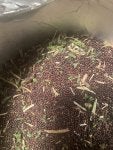Pulled into the canola this evening expecting it to be really dry but to my amazement the combine moisture tester was up around 16-18. This is straight cut L233 seeded mid May. Had 8 tenths of rain about 10 days ago. Last rain was June 7. Was a drought here and might be a 15-20bu/ac crop. Hopped into tank and the canola itself is indeed dry but there is a ton of green material from new buds on stems and new leaf material. It tested 11.5 on the moisture tester back at the yard. Is this green stuff going to dry down in the air bin if we cut it now?
It’s going to be super expensive to reglone and glyphosate will take forever. There are no existing sprayer tracks in the fields so will lose a decent amount to tramping. Swathing is hardly an option in this area with a light crop and bad winds we often get. What’s the best option here?
It’s going to be super expensive to reglone and glyphosate will take forever. There are no existing sprayer tracks in the fields so will lose a decent amount to tramping. Swathing is hardly an option in this area with a light crop and bad winds we often get. What’s the best option here?






